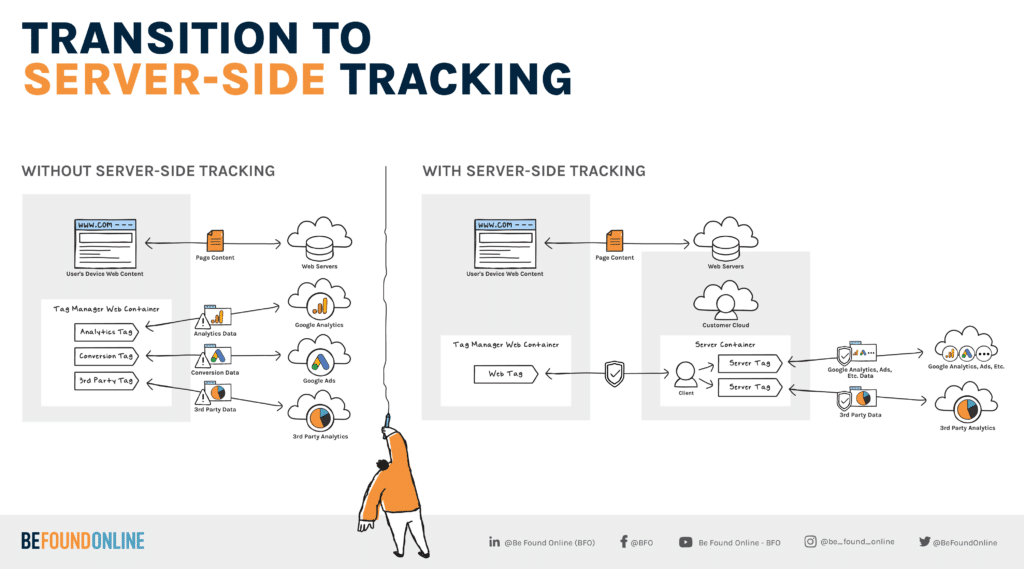Why You Need to Transition to Server-Side Tracking
February 24, 2023
7 Minute Read
As the digital marketing world continues to approach the sunset of Universal Analytics, businesses have been faced with challenge after challenge. Most are focused around the transition to Google Analytics 4. However, for many businesses, now is the perfect time to implement an important tracking solution and address issues relating to user privacy and missing data.
Back in 2020, Apple introduced iOS 14. Included were new privacy features that reopened the conversation about online user privacy on the modern web. Immediately after launch, businesses started to notice missing advertising data. To make things worse, more browsers and devices began to announce privacy forward features that placed restrictions on businesses’ ability to track ads. This sent shockwaves through the digital marketing community, as businesses scrambled to combat their biggest challenge yet.
Facebook (now Meta) was the first to respond. In 2020, they launched Conversions API (CAPI), which allowed businesses to send data about their conversions directly to Facebook without a pixel. In order to use CAPI, businesses utilized server-side tracking. Other ad platforms followed their lead; and Google has now made server-side tracking a cornerstone of its modern marketing suite.
These days, Google has released server-side implementations for Google Tag Manager, Google Cloud Platform, Google Analytics 4, Google Ads, Google BigQuery, and Looker Studio to help businesses keep their data optimized. These products are Google’s version of a complete, modern marketing suite. Unfortunately, for many businesses this has gotten lost in the shuffle of their GA4 migrations.
In this article, we’ll walk you through server-side tracking and give you the knowledge you need to adapt and stay ahead of the changes in the digital marketing landscape. You’ll learn how implementing server-side tracking can help you keep your data accurate in order to help you make data-driven marketing decisions and maximize the quality of your leads.
Pesky Pixels, JavaScript, Code Snippets, and Where It All Went Wrong
If you’ve set up an online ad campaign, you’ve probably had to go through the process of installing a code snippet on your website. Most often this code snippet contains a link to JavaScript hosted by someone else: Facebook, Google, Twitter, the list goes on… These days, it’s not just one or two: almost every site we visit loads numerous scripts from external (or third-party) sources. This practice has been in place for a long time, but over the years Big Tech started using this practice to take more information about your users than was their fair share.
Whenever a website loads third-party JavaScript, they are creating a direct link between the users’ device and the third-party. At the end of the day, Big Tech is in the business of data. They take it and repackage it, selling it back to you and your competitors as you seek conversions from their advertising networks. The privacy movement is a direct reaction to Big Tech being caught red handed. New browser rules and even legislation have been introduced to protect users’ right to privacy online. But in order to continue to operate, website owners need revenue and must continue to use online advertising networks. The result is that businesses now have increased responsibility to ensure their user’s data is safe from malicious attacks.
For a deeper dive into the legal battle surrounding cookies and user data, I highly suggest you check out our recent article on third-party cookies, tracking, and Javascript which helps paint a cohesive picture of the data privacy landscape.
How Does Server-Side Tracking Help?
Server-side tracking offers additional security features to help protect your user’s data. Your server lives on a subdomain of your website, and therefore is considered by browsers to be a part of your online application. This means that all cookies and JavaScript issued from your server are first-party. Once a first-party, server-side Google Tag Manager script is placed on a website, businesses are able to reduce their chances of having tracking blocked by most Ad Blockers.
If you are a more visual learner, the chart below depicts the differences in flow between server-side implementation and non-server-side implementation.

Website subdomains are secured by HTTPS Protocol. This means that any Personally Identifiable Information (PII) being processed by your server is safe from malicious hackers. This also applies other sensitive information, such as API Keys.
Server-side tracking places businesses in full control of all user data being sent to third-party platforms. This is configured during setup and allows businesses to be open, honest, and transparent in their data privacy policies. Combined with great cookie management and privacy policy implementation, server-side tracking is a business’ best tool to ethically operate on the modern web.
Okay, So What’s the Catch?
The biggest hurdle in migrating to server-side tracking is that it is far more technical than what most experienced Google Tag Manager users are accustomed to. Server-side GTM (SGTM) introduces Clients, a new entity alongside Tags, Triggers, and Variables. Clients process raw HTTP Requests received by your server and make the data contained within them available to your Tags, Triggers, and Variables.
Clients break the connection between a users’ device and the third party. They digest the data as it comes to your server, and the server-side Tags handle the transfer of data to the third-party. Clients remove any sensitive data about your users and send exactly what you intend to share with third parties and nothing more.
The introduction of Clients has also made the debugging process more challenging than before. Just like a web GTM Container, SGTM has a Preview Mode designed for debugging HTTP Requests. Users beginning to use SGTM should be familiar with HTTP Requests as they begin to learn how to set up their tracking. In many scenarios, users may find themselves working in both GTM Preview Modes simultaneously; as well as other debugging windows like GA4’s Debug Mode, or Facebook’s Events Manager.
The last downside of implementing server-side tracking is that it incurs a monthly cost. As mentioned earlier, server-side Google Tag Manager plays well with Google Cloud Platform, but Google has surprised users by making SGTM available for deployment on other platforms like AWS and Azure. Regardless of where you deploy your server, you will incur data processing costs depending on the volume of traffic your website receives. Don’t be alarmed, for most clients we are seeing this cost run between $120 – $150 per month. If you are curious about what it would cost your site, reach out to BFO.
The Possibilities Are Endless…
With server-side tracking, we can send data just about anywhere. Beyond the Google products listed in our introduction, Facebook, TikTok, Hotjar, Hubspot, Klaviyo, Salesforce, Zapier, and many, many more platforms have released support for server-side tracking with Google Tag Manager. It is the future of data tracking for online marketers, and we all are one day going to need to adapt to this reality. Browser tracking will eventually die, pixels will go away. We must adapt and evolve with the modern web or risk being left behind.
If you’re ready to step into the future, or if you just have more questions, reach out to the Analytics Team at Be Found Online. We’ve spent countless hours learning the ins and outs of SST and helping a variety of clients find the custom implementation that works best for them.

Jon Phillips
Jon is the epitome of what we look for in a good analyst: he loves solving problems and he has a knack for catching things that others overlook. In addition to his problem-solving prowess, Jon loves exploration and experimentation within his major hobbies of music, cooking and travel. He is a curious guy and his passion drives him to succeed in what he sets his mind to.
CATEGORIES
SUBSCRIBE TO OUR BLOG
Stay up to date with the latest industry best practices in digital marketing!























.png?width=339&height=179&name=Webinar%20Banner%20(1).png)



.png?width=339&height=179&name=July%20Webinar%20(Newsletter).png)

.png?width=339&height=179&name=Webinar%20Banner-April-02%20(1).png)
%20(4).png?width=339&height=179&name=Webinar%20Banner-May-02%20(1)%20(4).png)




.png?width=339&height=179&name=March%202023%20Webinar%20Ad%20(autoresponder).png)

















































